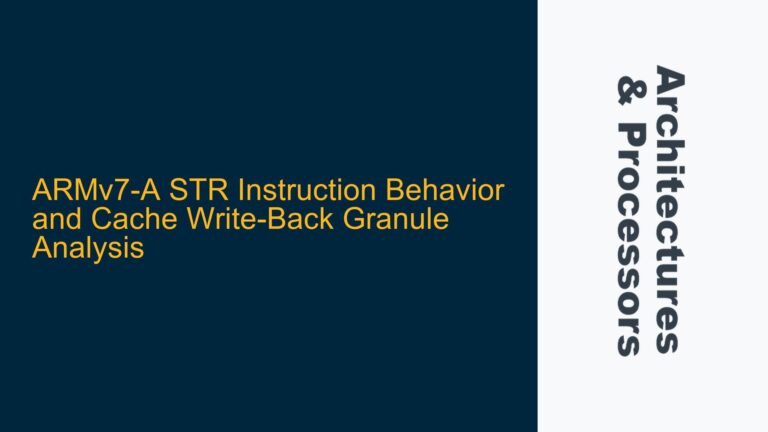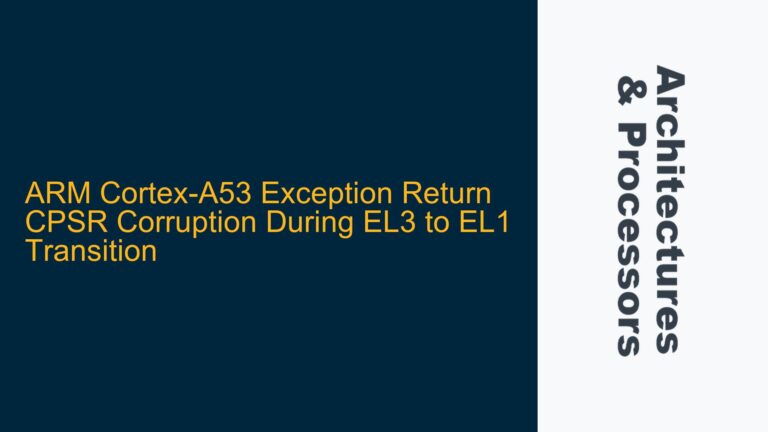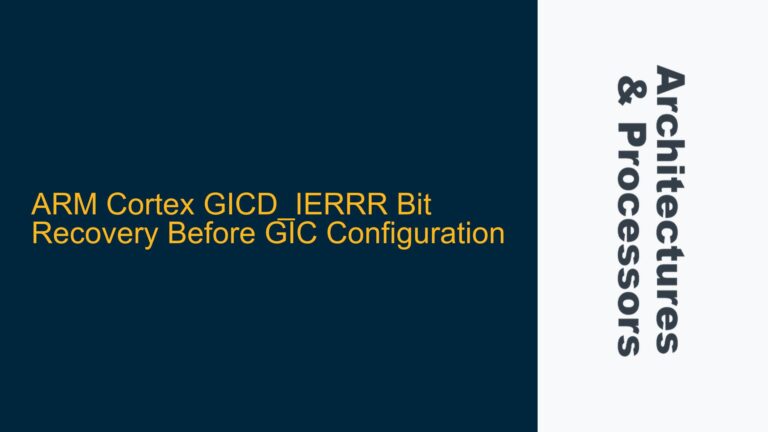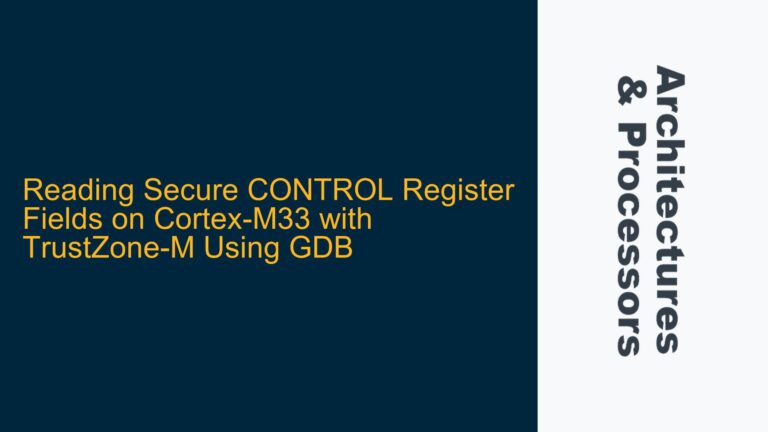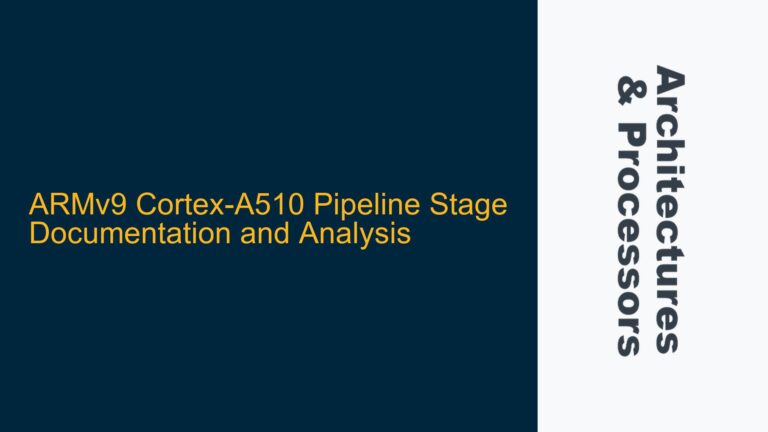ARM Cortex-A53 NEON Intrinsics Misalignment and Cache Coherency Issues
The issue described involves a "bus error" occurring when using the ARM NEON intrinsic vld2q_f32 on MediaTek MT676x series processors, specifically the MT6765 and MT6762. These processors are based on the ARM Cortex-A53 architecture, which implements the ARMv8-A instruction set. The vld2q_f32 intrinsic is designed to load two interleaved quadword (128-bit) floating-point vectors from memory into a float32x4x2_t structure. The error manifests when the intrinsic is called multiple times within a function, with the second call causing a bus error. Interestingly, inserting a printf() statement before the second call prevents the error, suggesting a timing or synchronization issue.
The ARM Cortex-A53 is a 64-bit RISC processor that supports Advanced SIMD (NEON) instructions for parallel data processing. The NEON unit operates on 128-bit registers and can perform operations on multiple data elements simultaneously. The vld2q_f32 intrinsic is part of the ARM C Language Extensions (ACLE) and is used to load two interleaved 128-bit floating-point vectors from memory. The intrinsic assumes that the input pointer is properly aligned to a 16-byte boundary, as required by the NEON unit.
The MT676x processors integrate the ARM Cortex-A53 cores with a custom memory subsystem, including caches and a bus interface unit. The bus error indicates that the processor is attempting to access memory in a way that violates the memory subsystem’s alignment or coherency rules. The fact that adding a printf() statement prevents the error suggests that the issue may be related to cache coherency or memory alignment, as the printf() function may introduce a delay or flush the cache, altering the timing of memory accesses.
Misaligned Memory Access and Cache Line Boundary Crossings
One possible cause of the bus error is misaligned memory access. The vld2q_f32 intrinsic requires the input pointer to be aligned to a 16-byte boundary. If the pointer is not properly aligned, the NEON unit may attempt to access memory across cache line boundaries, leading to a bus error. The ARM Cortex-A53 architecture enforces strict alignment requirements for NEON loads and stores, and violating these requirements can result in undefined behavior, including bus errors.
Another potential cause is cache line boundary crossings. The ARM Cortex-A53 uses a cache line size of 64 bytes. If the memory access spans multiple cache lines, the processor may need to perform multiple cache line fills or write-backs, which can introduce timing issues or coherency problems. The vld2q_f32 intrinsic loads 32 bytes of data (two 128-bit vectors), which may cross cache line boundaries if the input pointer is not aligned to a 16-byte boundary.
The MT676x processors may have additional memory subsystem constraints that exacerbate these issues. For example, the bus interface unit may have stricter alignment requirements or may not handle cache line crossings as gracefully as other ARM processors. The fact that the error does not occur on other ARM processors suggests that the MT676x processors may have unique memory subsystem characteristics that need to be taken into account when using NEON intrinsics.
The use of printf() to prevent the error may be masking the underlying issue by altering the timing of memory accesses or flushing the cache. The printf() function is a relatively slow operation that may introduce enough delay to allow the memory subsystem to handle the misaligned access or cache line crossing correctly. However, this is not a reliable solution and does not address the root cause of the problem.
Ensuring Proper Memory Alignment and Cache Coherency
To resolve the bus error when using the vld2q_f32 intrinsic on MT676x processors, it is essential to ensure proper memory alignment and cache coherency. The following steps outline the necessary actions to diagnose and fix the issue:
Step 1: Verify Memory Alignment
The first step is to verify that the input pointers passed to the vld2q_f32 intrinsic are properly aligned to a 16-byte boundary. This can be done by checking the alignment of the pointers before using them in the intrinsic. The following code snippet demonstrates how to check the alignment of a pointer:
#include <stdint.h>
#include <stdio.h>
void check_alignment(const float* ptr) {
if ((uintptr_t)ptr % 16 != 0) {
printf("Pointer %p is not aligned to a 16-byte boundary\n", (void*)ptr);
} else {
printf("Pointer %p is aligned to a 16-byte boundary\n", (void*)ptr);
}
}
If the pointers are not properly aligned, the memory allocation should be adjusted to ensure 16-byte alignment. For dynamically allocated memory, the posix_memalign or aligned_alloc functions can be used to allocate aligned memory:
#include <stdlib.h>
float* allocate_aligned_memory(size_t size) {
float* ptr;
if (posix_memalign((void**)&ptr, 16, size) != 0) {
return NULL;
}
return ptr;
}
For statically allocated memory, the alignas specifier can be used to ensure proper alignment:
#include <stdalign.h>
alignas(16) float array[32];
Step 2: Ensure Cache Coherency
The next step is to ensure cache coherency when using NEON intrinsics. The ARM Cortex-A53 processor uses a write-back cache policy, which means that data written to the cache may not be immediately written back to memory. This can lead to coherency issues if the same memory is accessed by different parts of the system, such as the CPU and DMA controllers.
To ensure cache coherency, it may be necessary to use memory barriers or cache maintenance operations. The ARMv8-A architecture provides several instructions for managing cache coherency, including the Data Memory Barrier (DMB), Data Synchronization Barrier (DSB), and Instruction Synchronization Barrier (ISB). These instructions can be used to ensure that memory accesses are properly ordered and that the cache is in a consistent state.
The following code snippet demonstrates how to use the __dmb() intrinsic to insert a memory barrier:
#include <arm_acle.h>
void ensure_cache_coherency() {
__dmb(0xF); // Full system memory barrier
}
In addition to memory barriers, it may be necessary to invalidate or clean the cache to ensure that the data in memory is up to date. The ARMv8-A architecture provides the DC CIVAC (Data Cache Invalidate by Virtual Address to Point of Coherency) and DC CVAC (Data Cache Clean by Virtual Address to Point of Coherency) instructions for this purpose. These instructions can be accessed using the __builtin___clear_cache() intrinsic:
void invalidate_cache(void* start, void* end) {
__builtin___clear_cache(start, end);
}
Step 3: Debugging and Profiling
If the issue persists after ensuring proper memory alignment and cache coherency, it may be necessary to use debugging and profiling tools to further diagnose the problem. The ARM DS-5 Development Studio provides a comprehensive set of tools for debugging and profiling ARM-based systems, including the MT676x processors.
The DS-5 Debugger can be used to set breakpoints, inspect memory, and analyze the execution flow of the application. The Streamline Performance Analyzer can be used to profile the application and identify performance bottlenecks or coherency issues.
When using the DS-5 Debugger, it is important to set breakpoints on the vld2q_f32 intrinsic and inspect the memory addresses being accessed. The debugger can also be used to verify the alignment of the pointers and the state of the cache.
The Streamline Performance Analyzer can be used to monitor cache usage and identify any cache misses or coherency issues. The analyzer can also be used to measure the impact of memory barriers and cache maintenance operations on performance.
Step 4: Optimizing NEON Code
Finally, it is important to optimize the NEON code to minimize the risk of alignment and coherency issues. This includes using aligned memory accesses, minimizing the use of memory barriers, and optimizing the data layout to reduce cache line crossings.
The following code snippet demonstrates how to optimize the use of the vld2q_f32 intrinsic by ensuring that the input pointers are aligned and that the data is laid out in a way that minimizes cache line crossings:
#include <arm_neon.h>
#include <stdlib.h>
void optimized_neon_function(float* aligned_ptr1, float* aligned_ptr2, float* aligned_ptr3, float* aligned_ptr4) {
float32x4x2_t vmm0;
vmm0 = vld2q_f32(aligned_ptr1);
vmm0 = vld2q_f32(aligned_ptr2);
vmm0 = vld2q_f32(aligned_ptr3);
vmm0 = vld2q_f32(aligned_ptr4);
// Perform NEON operations on vmm0
}
In this example, the input pointers are assumed to be properly aligned, and the data is laid out in a way that minimizes cache line crossings. This reduces the risk of bus errors and improves the performance of the NEON code.
By following these steps, it is possible to resolve the bus error when using the vld2q_f32 intrinsic on MT676x processors and ensure that the NEON code is both correct and efficient.

